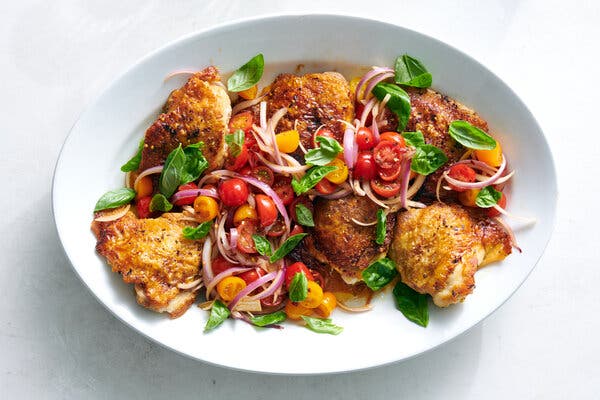A Good Appetite
Golden, salty schmaltz seasons a vibrant tomato and onion salad in this savory dish from Melissa Clark.
Listen to this article · 2:33 min Learn more
I’ve long hoarded the fat from every strip of bacon, every duck breast or leg I cook, decanting the drippings into jars like drops of a golden elixir. Almost every potato that enters my house gets the duck fat treatment for roasting. I smear bacon fat on the bread to ennoble a classic BLT. And I’ve been known to spoon the oil right off the top of braised short ribs onto the noodles I’ll be serving alongside them.
But for some reason, I’ve never been quite so ambitious with chicken.
Recipe: Skillet Chicken Thighs With Schmaltzy Tomatoes
I can feel the ancestral side eye every time I slide an oily skillet or roasting pan into the sink, defiling perfectly good grease with soapy water. “Shame!” my family tree whispers. “Wasting perfectly good schmaltz!”
So I figure it’s high time to mend my ways and tap into a time-honored frugality that also happens to be an easy way to add deep, rich flavor.
The surest method I’ve found is to use the chicken schmaltz while it’s still warm from the pan, rather than storing it in the fridge for later.
If I’ve just skillet-roasted a chicken, for example, I make sure to sauté some vegetables in the fresh fat while the bird rests. I simply transfer the chicken to a platter or cutting board, then add, say, garlic, kale and chile flakes, or perhaps shallots, zucchini and herbes de Provence to the pan, and cook them for a few minutes. A speedy, colorful vegetable side dish.
But I took an even easier —- and cooler — path for this summery recipe. After cooking some chicken thighs in a skillet, I poured their sizzling, savory renderings over a bowl of sliced tomatoes and red onions. The hot fat softened the onions and made the tomatoes even juicier, but there was not enough to cook either one. They kept their textures and soaked up all the caramelized salty bits that I used to abandon at the bottom of the pan.
This kind of recipe is ripe for improvisation. Replace the tomatoes with another vegetable, the onions with any allium. Hot schmaltz makes tender greens, like watercress and spinach, collapse in an appealing way, while sturdier ingredients, such as sugar snap peas, radishes or cucumbers, retain their shape while absorbing the rich drippings.
As my forebears knew well, it’s worth getting a little schmaltzy in the kitchen.
Melissa Clark has been writing her column, A Good Appetite, for The Times’s Food section since 2007. She creates recipes for New York Times Cooking, makes videos and reports on food trends. She is the author of 45 cookbooks, and counting. More about Melissa Clark
